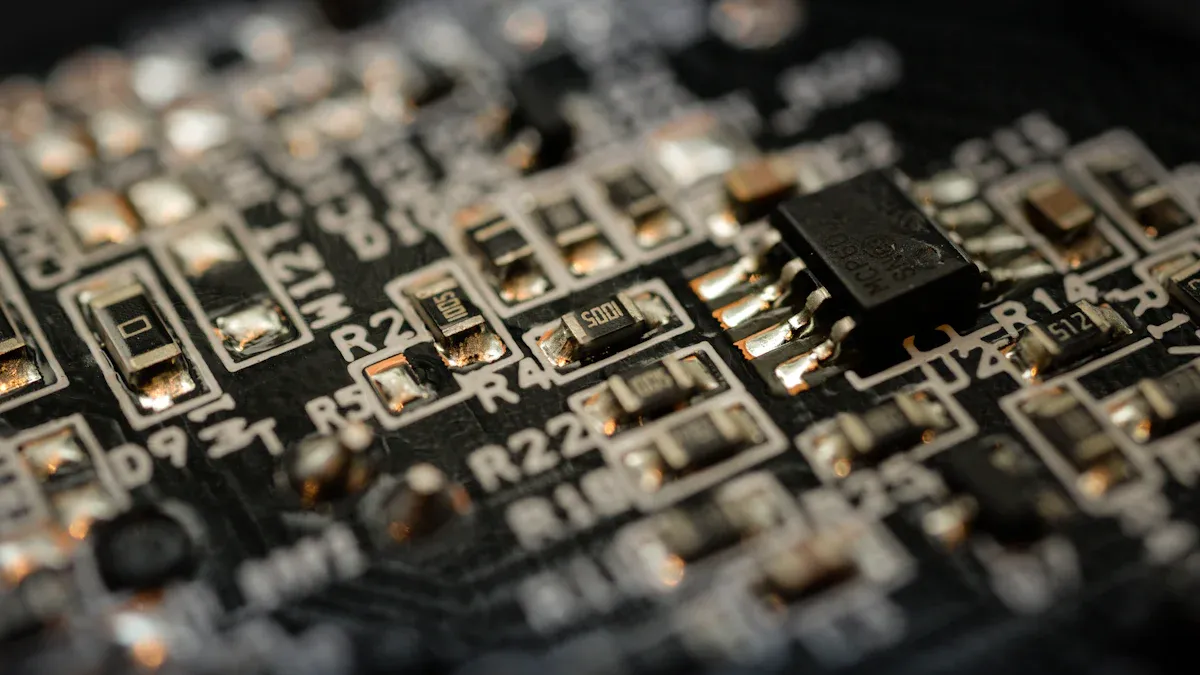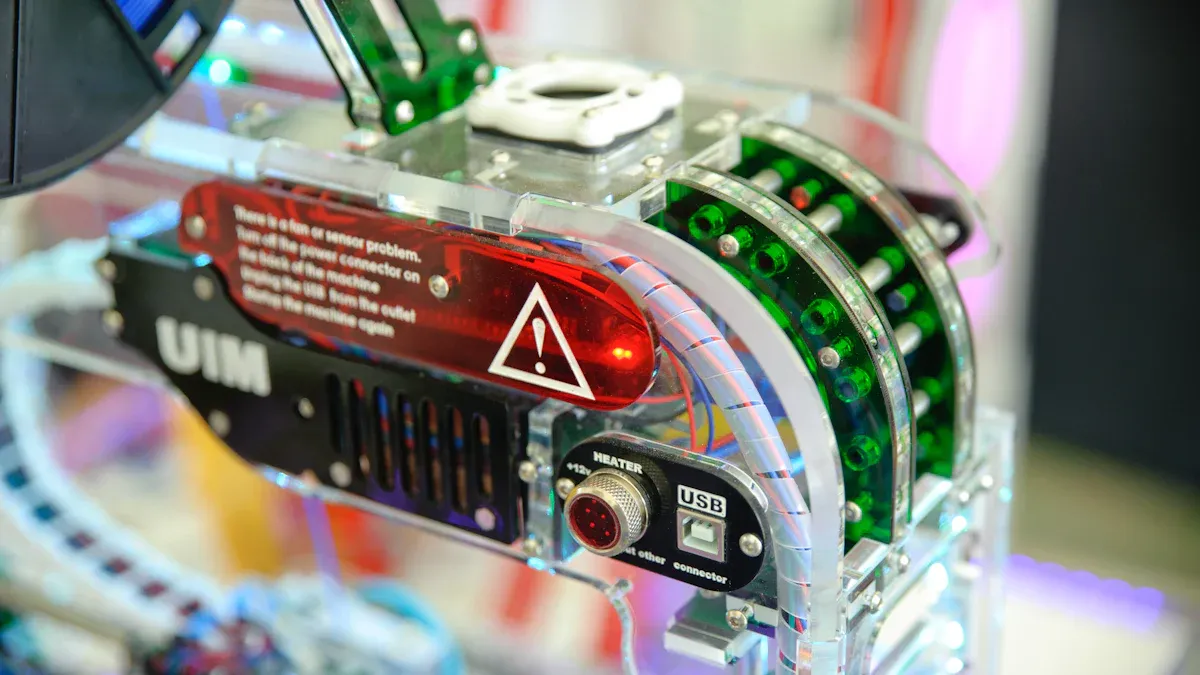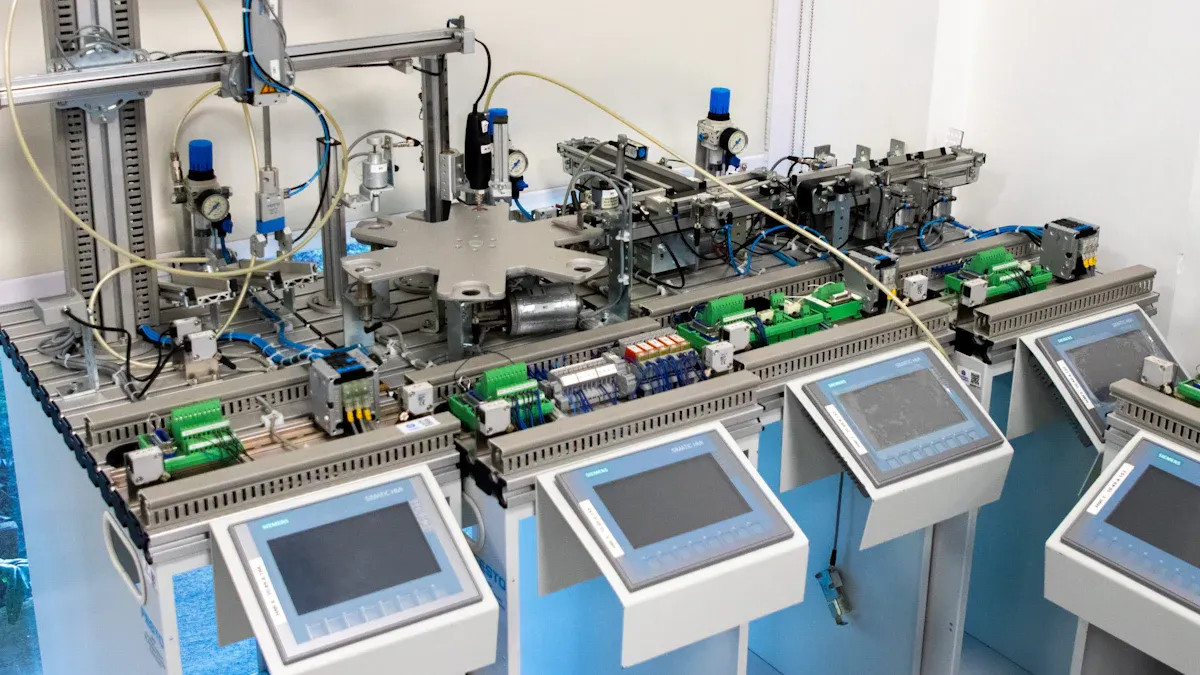
You use NG/OK conveyor to sort printed circuit boards (PCBs) by inspection results in your SMT line. These machines move good PCBs to the next step and separate faulty ones for review. You improve efficiency and reduce errors when you automate this process. You connect these machines with inspection equipment, which helps you lower waste and keep quality standards high.
Key Takeaways
-
NG/OK conveyors automate the sorting of printed circuit boards (PCBs), improving efficiency and reducing manual handling.
-
These machines help maintain high quality by separating good boards from faulty ones, minimizing errors and waste.
-
Integrating NG/OK conveyors with inspection equipment allows for real-time sorting based on inspection results, enhancing accuracy.
-
Regular maintenance and staff training are essential to keep NG/OK conveyors running smoothly and to avoid production delays.
-
Monitoring performance metrics like sorting speed and error rates helps identify issues early and supports continuous improvement.
NG/OK Conveyor Overview

What They Are
You use NG/OK conveyors to sort printed circuit boards (PCBs) after inspection in your SMT line. These machines help you separate boards that pass inspection from those that do not. NG/OK conveyor acts as an automated gatekeeper, making sure only quality boards move forward. They feature a compact design, so you can fit them into most production lines without taking up much space.
Here is a quick look at their main components and design features:
|
Feature/Specification |
Details |
|---|---|
|
Control Panel |
User-friendly membrane control panel |
|
Belt Type |
Wear-resistant anti-static belts |
|
Operation Modes |
FIFO, LIFO, Pass-through |
|
Width Adjustment |
Parallel and smooth (lead screw) |
|
Safety Design |
Enclosed design for safety |
|
Compatibility |
SMEMA compatible |
|
Cycle Time |
Approx. 10 seconds |
|
PCB Size (MM) |
5050-530460 (model dependent) |
How They Work
You place the NG/OK conveyor right after your inspection equipment. The machine receives signals from the tester, then sorts each PCB into either the “OK” or “NG” (No Good) path. This process happens automatically, so you do not need to move boards by hand. The conveyor uses a reliable buffer system to store boards and prevent jams.
|
Feature |
Description |
|---|---|
|
Purpose |
Used for caching and re-judgment of PCB boards on the SMT production line. |
|
Functionality |
Sorts and stores NG and OK PCBs separately to streamline the assembly process and prevent errors. |
|
Efficiency |
Provides a reliable and easy-to-use buffer system for electronics manufacturers. |
Role in SMT Lines
You rely on NG/OK conveyors to keep your SMT line running smoothly. These machines, located next to your testing equipment, manage PCB quality by sorting boards based on inspection results. You can trust them to store NG and OK boards in separate areas, which helps you avoid mix-ups and maintain high quality. NG/OK conveyor also supports various operation modes, such as FIFO or pass-through, allowing you to tailor them to your workflow.
Tip: By using NG/OK conveyors, you reduce manual handling and lower the risk of errors in your production line.
Applications in SMT Lines

Automated Sorting After Inspection
You can use the NG/OK conveyor to automate the sorting of PCBs right after inspection. When your boards leave the AOI (Automated Optical Inspection) or ICT (In-Circuit Test) station, these machines take over. They receive inspection results and then sort each board into the correct path. Good boards move forward, while faulty ones go to a separate area for review. This process reduces the need for manual handling and helps you avoid mistakes.
Here is a quick look at how these machines improve your workflow:
|
Feature |
Description |
|---|---|
|
Advanced Sorting Modes |
NG buffer machines automatically store and sort good and bad PCBs, reducing manual intervention. |
|
Efficiency Improvement |
The sorting process enhances inspection efficiency by minimizing the need for human oversight. |
|
Temporary Storage |
PCB buffers adjust the pace and temporarily store boards, preventing production line stoppages. |
You can see that NG/OK Screening Machines help you keep your line moving and reduce downtime.
Integration with Inspection Equipment
You connect NG/OK conveyor directly to your inspection equipment. This integration allows the machines to receive real-time inspection data. When a board passes or fails, the machine reacts instantly. You do not need to rely on workers to move boards or make decisions. This setup increases your accuracy and keeps your process consistent. You also lower the risk of mixing up good and bad boards.
Hierarchical Storage and Buffering
You benefit from hierarchical storage and buffering features in the NG/OK conveyor. These machines can store boards in different sections based on their inspection results. Good boards stay ready for the next step, while faulty ones wait for further analysis. This system prevents bottlenecks and keeps your production line balanced. You can also use the buffer to temporarily hold boards if the next process slows down. This flexibility helps you maintain a steady workflow and avoid unnecessary stops.
Tip: By using NG/OK conveyor, you can handle more boards with less effort and keep your quality control strong.
Benefits of NG/OK Conveyor
Efficiency and Throughput
You can boost your SMT line’s efficiency by using NG/OK conveyors. These machines sort NG and OK PCBs quickly and accurately. When you automate this process, you minimize errors and keep your production moving. The SMT PCB NG/OK Unloader Magazine helps you manage buffers better. This means you can handle more boards in less time and avoid slowdowns. You see higher throughput because the line does not stop for manual sorting or inspection delays.
Tip: Automated sorting keeps your line balanced and prevents bottlenecks, so you can meet production targets with less stress.
Error and Waste Reduction
You reduce mistakes and waste when you rely on NG/OK conveyors. Manual sorting often leads to errors, especially when workers get tired or distracted. Automation solves this problem by making sure each board goes to the right place every time. You also lower the risk of mixing good and bad boards, which protects your product quality.
-
The NG/OK Unloader Machine automates the sorting of PCBs, reducing the need for manual labor.
-
This automation minimizes human error, enhancing production accuracy.
-
Increased production efficiency leads to lower labor costs in SMT manufacturing.
You save money because you need fewer workers for sorting tasks. You also waste fewer boards since the system catches defects early and keeps them separate from good products.
Data and Traceability
You gain better control over your production data with NG/OK conveyors. These machines work well with your inspection and control systems. You can track each board as it moves through the line. This traceability helps you find problems faster and fix them before they affect more products. You also collect valuable data for quality reports and audits.
|
Benefit |
Description |
|---|---|
|
Real-time Tracking |
You monitor each PCB’s status instantly. |
|
Quality Reports |
You generate accurate records for every batch. |
|
Fast Problem Solving |
You identify and address defects quickly. |
NG/OK conveyor supports your quality goals by making it easy to trace every board and keep your records up to date.
Implementation Considerations
Equipment Compatibility
You need to check if your NG/OK conveyor matches your current SMT line equipment. Most NG/OK conveyor supports SMEMA standards, which makes integration easier. You should look at the size of your PCBs and the conveyor’s width adjustment features. Some machines work best with specific inspection systems, such as AOI or ICT. You can use the table below to compare key compatibility factors:
|
Compatibility Factor |
What to Check |
|---|---|
|
PCB Size Range |
Fits your board dimensions |
|
Signal Interface |
Matches AOI/ICT output signals |
|
Conveyor Height |
Aligns with your line setup |
|
Control Protocol |
Supports your automation system |
Tip: Always review your equipment manuals before installing a new conveyor. This helps you avoid connection issues and downtime.
Customization and Scalability
You can customize NG/OK conveyors to fit your production needs. Many manufacturers offer options for belt type, buffer size, and operation modes. You may want to add extra storage for NG boards or change the sorting logic. If your production volume grows, you can scale up by adding more conveyors or expanding buffer capacity. You should plan for future changes when choosing your machine.
-
Choose an adjustable width for different PCB sizes.
-
Select operation modes like FIFO or pass-through.
-
Add extra buffer sections for high-volume lines.
Note: Customization lets you adapt quickly to new products or process changes.
Maintenance Needs
You must keep your NG/OK conveyor in good condition to ensure reliable performance. Regular cleaning of belts and sensors prevents jams and errors. You should inspect moving parts for wear and replace them as needed. Most machines have simple maintenance routines, so your staff can handle basic tasks. You can set a schedule for checks and cleaning to avoid unexpected breakdowns.
-
Clean belts and sensors weekly.
-
Check for loose screws or worn parts monthly.
-
Update software and control settings as needed.
Maintenance keeps your conveyor running smoothly and protects your investment.
Best Practices
System Integration
You should connect your NG/OK conveyor with your inspection and automation systems for the best results. Start by checking that your conveyor supports SMEMA or other standard interfaces. This step helps you avoid connection problems. Use the same communication protocols across your equipment. You can work with your equipment supplier to set up the integration. Test the system with a few boards before running full production. This approach lets you catch issues early.
Tip: Keep a wiring diagram and software settings handy. This information helps you troubleshoot quickly if problems come up.
Staff Training
You need to train your staff to use and maintain the NG/OK conveyor. Begin with a hands-on demonstration. Show your team how to load boards, read the control panel, and respond to alarms. Use simple checklists for daily and weekly tasks. Encourage your staff to ask questions during training. You can also create quick reference guides for new operators.
Key training topics:
-
Safe operation of the conveyor
-
Recognizing and responding to error messages
-
Basic cleaning and maintenance steps
Note: Well-trained staff help you avoid downtime and keep your line running smoothly.
Performance Monitoring
You should monitor your NG/OK conveyor’s performance to keep your SMT line efficient. Track the number of boards sorted, error rates, and downtime. Use the conveyor’s built-in data features if available. Review this data weekly to spot trends or problems. Set clear targets for sorting speed and accuracy.
|
Metric |
What to Watch For |
|---|---|
|
Sorting Speed |
Boards per hour |
|
Error Rate |
Incorrect sorting of events |
|
Downtime |
Minutes per week |
Regular monitoring helps you catch small issues before they become big problems. This practice supports your quality goals and keeps your production on track.
You can strengthen your SMT line quality control by using NG/OK Screening Machines. These machines help you boost efficiency, cut errors, and keep your product quality high. Review your current process and see where you can improve. If you want to learn more, reach out to equipment suppliers or research new solutions for your production line.
FAQ
What does NG/OK mean in SMT production?
NG stands for “No Good,” and OK means “Good.” You use these terms to sort PCBs after inspection. NG boards need review or repair. OK, boards move to the next process.
How do NG/OK conveyors connect to inspection machines?
You connect NG/OK conveyors using standard interfaces like SMEMA. The conveyor receives inspection results directly from AOI or ICT machines. This setup lets you automate sorting and reduce manual handling.
Can you adjust the NG/OK conveyors for different PCB sizes?
Yes, you can adjust the conveyor width for various PCB sizes. Most machines use a lead screw or similar mechanism. This feature helps you handle different products without changing equipment.
What maintenance do NG/OK conveyors need?
You should clean the belts and sensors regularly. Check for loose screws or worn parts each month. Follow the manufacturer’s maintenance schedule to keep your conveyor running smoothly.
Do NG/OK conveyors store data for traceability?
Many NG/OK conveyors support data collection. You can track each board’s status and generate quality reports. This feature helps you find defects quickly and improve your process.
